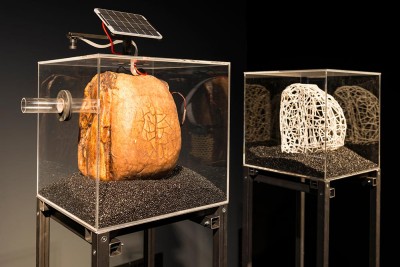Belgian artist AnneMarie Maes presents her project ‘Sensorial Skin for an Intelligent Guerilla Beehive’.
‘The Intelligent Guerilla Beehive is a speculative research project that combines in a radical way smart materials, biomimetic forms and biotechnology. It is inspired by the intelligence, complexity and self-organisation of bee colonies as Super Organisms.


Intelligent Guerilla Beehive.
Installation shot@ OK Offenes Kulturhaus / Center for Contemporary Art, Linz/A
Photo: Otto Saxinger
‘Sensorial Skin for an Intelligent Guerilla Beehive’ is a bio-art installation on the edge of art and science. It evokes issues of sustainability and biodiversity, giving viewers an artistic experience of my ongoing research related to the disappearance of the honeybee.
Bees are bio-indicators. They reflect the health of their surrounding ecosystem as well as the cumulative effects of different pollutants. But in many industrialized nations bee colonies are now threatened. Pesticides and parasites are among the main factors, but equally worrisome is air pollution and the compromised state of the bees’ foraging fields. To tacle the unfairness against honeybees, I developped a radically new beehive: The Intelligent Guerilla Beehive. This mobile shelter for swarming honeybees is designed for urban environments. It supports the bee colonies in their pollination tasks, and as result indemnifies the biodiversity of their foraging fields.
The research and development of the device have also been a starting point for exploring possible futures through artistic experiments on materials science and biotechnology. The Sensorial Skin – the outer membrane of the Intelligent Guerilla Beehive – is a smart fabric grown by Acetobacter bacteria and yeast cells. It is augmented with a mix of organic and electronic elements for sensing and actuating, for computation and for communication. Lactobacillus plantarum bacteria living in a biofilm on the upper cellulose skin act as biosensors. When they sense a specific degree of pollution, they are changing colors and making patterns that reflect the environmental threats. The double-sided skin, wrapped at one side in a bacterial biofilm and at the other side covered by a pattern of porous stomata, is also giving room to beneficial micro-organisms to attack the bees’ natural enemy the Varroa destructor mite.
Most of the experiments were run in my ‘Laboratory for Form and Matter’ where I work with a range of biotic and abiotic elements. I view my lab as an open environment for experimentation, a space for contradiction, criticism and evaluation. I combine organic components such as vegetal matter, propolis and chitine, with living systems such as fungi and bacteria. My micro-organisms grow biofabrics and I research how these membranes can be enhanced and made useful through embedded electronics and how more sensorial qualities can be implemented in these membranes via living technology. Navigating between blueprint and ‘Proof of Concept’, the resulting prototype can be classified as ‘Future Archaeology’: a fragment of a Forgotten World as well as a fragment of a World To Come.’
